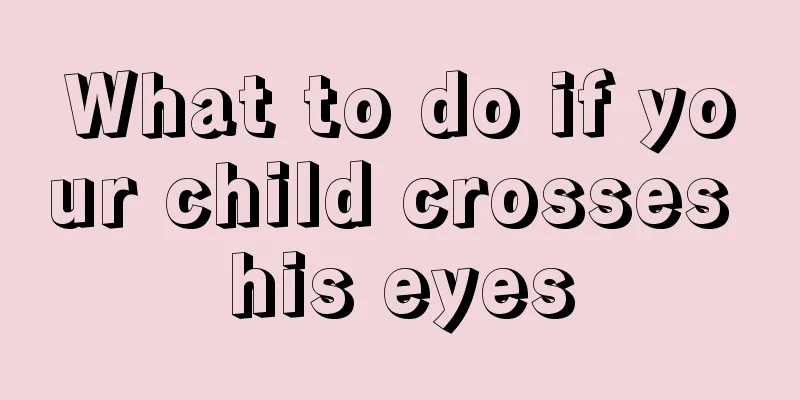What to do if your child crosses his eyes

|
You may not understand the meaning of crossed eyes. It is actually what we often call cross-eyes. Cross-eyes means that the pupils in the middle of the eyes are naturally or artificially moved closer to the middle, and they look like two chickens fighting, so it is called cross-eyes. Cross-eyes are often hereditary and are considered unsightly by many people. Here are some treatment methods to help you. Treatment: 1. For asymptomatic latent strabismus, no treatment is required because children have strong fusion and convergence abilities. However, some children with latent strabismus experience symptoms of visual fatigue such as eye swelling, orbital pain, and headache after viewing objects at close range, and appropriate treatment can be given. For esotropia, the pupil needs to be dilated and the eyes need to be refraction tested. Those with hyperopia should be fitted with appropriate glasses. For exotropia, convergence training can be performed to strengthen the adductor muscles of both eyes to overcome the exotropia. If the effect is not good, prism glasses can be worn. For exotropia greater than 10° (20Δ) when looking at near objects, surgical treatment can be considered. 2. Use different treatment methods according to the different causes of strabismus: Although congenital esotropia in concomitant strabismus has nothing to do with eye adjustment, it has a great impact on the development of binocular single vision function. The best treatment is surgical correction at the early stage of visual function development at the age of 2. Esotropia that occurs after the age of 2 to 3 is mostly related to excessive accommodative convergence caused by hyperopia. This type of strabismus requires full mydriasis and eye examination. Those with hyperopia should be fitted with adequate glasses and wear them for 3 to 6 months to correct or partially correct the strabismus, and then surgical treatment can be performed for any remaining esotropia. If the esotropia does not change after wearing glasses, the only treatment is surgery. If the strabismus is completely corrected, you can continue to wear glasses. If the hyperopia is very high, you can also correct the strabismus through surgery and reduce the degree of glasses you need to wear. 3. Considering the close relationship between accommodation and strabismus, hyperopia is prone to esotropia, and myopia is prone to exotropia. In addition, good vision is the basis for normal retinal correspondence and fixation of both eyes. Different vision can also cause strabismus and amblyopia. It can be seen that strabismus, amblyopia and refractive errors are closely related, so mydriasis refraction is the first step in examining children for strabismus. Wearing glasses to correct refractive error is an important method for treating strabismus in children. Children with strabismus and refractive errors, especially those with esotropia who develop the disease at the age of 2 to 3 and have hyperopia, should wear glasses for treatment, because hyperopia correction glasses are particularly effective at this time. They can correct excessive eye accommodation and restore convergence power to normal. For many children, esotropia can be completely corrected after wearing glasses for a period of time. 4. Clinically, except for accommodative esotropia which is completely caused by excessive accommodation and excessive convergence of hyperopia, which can be completely corrected by wearing glasses, all other types of strabismus basically require surgical correction. Obtaining a certain degree of fusion function after strabismus surgery will be beneficial to maintaining the correct eye position. Correct eye position can restore normal or a certain degree of stereoscopic vision for some patients, especially intermittent or recently onset patients, who can expect to obtain good binocular single vision function. Therefore, no matter what kind of strabismus, when conservative methods and training therapy are ineffective, surgery can restore the normal coordinated function of the eye muscles. Not only will the strabismus become straight when in the original position, but the movements in all directions will be synchronized. The patient can have single vision with both eyes and stereoscopic vision. If the surgery has no adverse complications, surgery can be performed. prevention 1. After 2 months, the baby's vision improves and he can pay attention to people and objects around him. At this time, if the baby sleeps in a cradle, do not place toys or objects in the air near the cradle, especially do not place anything within 1.5 meters. 2. If you place toys or objects, make sure they are 1.5 meters away. But do not place just one. Place several at intervals so that the baby can move his eyes and look at the toys or objects in turn. 3. If you place toys or objects, make sure they are 1.5 meters away. But do not place just one. Place several at intervals so that the baby can move his eyes and look at the toys or objects in turn. 4. The baby’s sleeping position must be correct and must not sleep on one side for a long time. |
<<: How to make children gain weight?
>>: What to do if the child's rash does not come out
Recommend
What diseases does the chickenpox vaccine prevent?
Vaccination against chickenpox in children is par...
What are the methods of weaning children?
Everyone knows that newborn babies usually grow u...
Baby still hurts after dislocation reduction
Young children are naughty and active. They alway...
Early symptoms of Kawasaki disease
When it comes to Kawasaki disease, most people ma...
Are active children smart?
Different people will show different personality ...
Clinical manifestations of Helicobacter pylori in children
There are many common diseases in children. When ...
How to whiten a child’s tanned skin?
There are a lot of people with dark skin, and the...
What causes a child’s ears to suddenly swell?
If a child's ears suddenly swell, the child w...
Newborns must be careful about the dangers of mouth breathing
Many newborns breathe through their mouths, so wh...
What food should I eat to remedy a child’s slow growth?
Parents are the most anxious when their children ...
What department should I go to for frequent urination in children?
Frequent urination does not only occur in adults,...
What to do if your child has stomachache
The stomach is an important digestive and absorpt...
What causes excessive sweating in children?
Children always sweat a lot, which makes many par...
Symptoms of urethritis in children
Urethritis is no longer just a disease that occur...
What to do if your child has red bloodshot eyes?
What's going on with the red bloodshot in my ...









